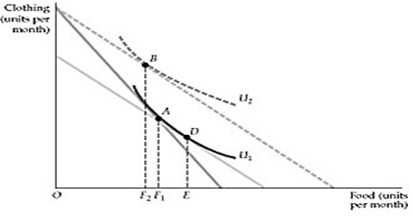Reference no: EM133195714
Assignment:
Multiple Choice:
1) Indifference curves are convex to the origin because of:
A) transitivity of consumer preferences.
B) the assumption of a diminishing marginal rate of substitution.
C) the assumption that more is preferred to less.
D) the assumption of completeness.
E) none of the above
2) If indifference curves cross, then:
A) the assumption of a diminishing marginal rate of substitution is violated.
B) the assumption of transitivity is violated.
C) the assumption of completeness is violated.
D) consumers minimize their satisfaction.
E) all of the above
3) Envision a graph with meat on the horizontal axis and vegetables on the vertical axis. A strict vegetarian would have indifference curves that are:
A) vertical lines.
B) horizontal lines.
C) diagonal straight lines.
D) right angles.
E) upward sloping.
4) The price of lemonade is $0.50; the price of popcorn is $1.00. If Fred has maximized his utility by purchasing lemonade and popcorn, his marginal rate of substitution will be:
A) 2 lemonades for each popcorn.
B) 1 lemonades for each popcorn.
C) 1/2 lemonade for each popcorn.
D) indeterminate unless more information on Fred's marginal utilities is provided.
5) Assume that beer is a normal good. If the price of beer rises, then the substitution effect results in the person buying ________ of the good and the income effect results in the person buying ________ of the good.
A) more; more
B) more; less
C) less; more
D) less; less
6) Some luxury product manufacturers will purposefully raise prices on their goods in order to reduce sales volume. This strategy may successfully increase sales revenue if the luxury goods are subject to the ________ effect and have relatively ________ demand.
A) bandwagon; elastic
B) bandwagon; inelastic
C) snob; elastic
D) snob; inelastic

7) Refer to Figure above. The effect of a decrease in the price of food, as depicted in the figure, leads us to believe that:
A) food is an inferior good and clothing a Giffen good.
B) food is a normal good and clothing a Giffen good.
C) food is a Giffen good and clothing a normal good.
D) food is a Giffen good and clothing an inferior good.
8) When an investor purchases a share of stock at $50 and the stock tumbles to $35, the investor with loss aversion prefers to:
A) sell the stock at $35 and use the proceeds to make a better investment.
B) keep the stock and avoid the losses, at least until the price returns to $50.
C) buy more shares at 35 dollars.
D) leave the stock market.
9) In the ultimatum game, the basic theory of utility would suggest that the optimal distribution (outcome of the game) of $100 is, for you and the stranger, respectively:
A) $99; $1.
B) $50; $50.
C) $67; $33.
D) none of the above
10) The reason why so many price tags end in 95 or 99 is based on the understanding that consumers tend to overemphasize:
A) the first digit of prices.
B) the last two digits of prices.
C) the attractiveness of prices stated in cents.
D) the savings associated with even one cent.
Short Answer:
1) Draw indifference curves that represent the following individuals' preferences.
a) Juan loves pizza and beer, but he insists on consuming exactly two beers for every one slice of pizza that he eats (perfect complements).
b) Hakeem loves soda, and views Coke and Pepsi as perfect substitutes.
c) Xiao likes both hotdogs and hamburgers, and his preferences satisfy assumptions 1 through 4 of rational preferences as discussed in class.
2) Howard has the following utility function:
U(X,Y)=X2Y
where X is his consumption of turtlenecks, with Px=$8, and Y is coffee, with Py=$2.
Assume that his income is $120. How many turtlenecks and how much coffee will Howard consume?
Suppose the price of turtlenecks increases from $8 to $16. What is the effect of the price increase on Howard's consumption of turtlenecks?
c) Are turtlenecks and coffee substitutes or complements? Explain.
Draw Engel curves corresponding to each of the following scenarios.
Pizza is a normal good at all income levels.
Pizza is an inferior good at all income levels.
Pizza is a normal good at low levels of income, but an inferior good at high levels of income.